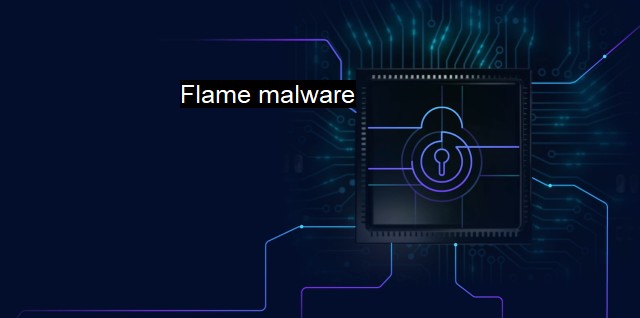What is Flame malware?
The Massive and Sophisticated Flame Malware: An Advanced Cyber Attack Targeting Political Figures in the Middle East
Flame malware, also known as Flamer, sKyWIper or Skywiper, is a highly sophisticated, complex and elusive cyber espionage weapon designed to gather sensitive data. Uncovered by security researchers around 2012, it is considered one of the most menacing forms of malware to appear in the cyber world, causing repercussions in the field of cybersecurity and spurring antivirus companies to upgrade their technology considerably.This nefarious program garnered attention due to its revolutionary, intricate nature disrupting conventional comprehension of malware capabilities. Renowned for being modular, the Flame malware can adapt and evolve. It can, for instance, utilize its Bluetooth functionality to access other systems or gouge large swathes of data, racing its way through networks with the eeriness of a sci-fi horror villain. As it luxuriously spreads, it drills its stealthy tendrils into various elements of systems, replicating itself and hiding away like the proverbial monster in dark abysses of servers, far out of sight from conventional forms of detection.
At its core, the primary motivation behind the design and deployment of Flame was data theft and espionage, and not financial or monetary motivations commonly associated with many forms of malware, hence widening the cybersecurity landscape to include more than just banking and financial sectors. Flame can record audio, screenshots, keystrokes and even network traffic. All this information enables the attacker to gain brutal visibility and unlimited access to confidential and proprietary information.
When first discovered, it appeared to primarily attack computers in the Middle East, leading experts to posit that it was designed for nation-based espionage. the high-profile nature of the virus trained the spotlight of scrutiny onto methodologies employed by antivirus firms, placing them in a position where they had to stay a step ahead of a seemingly perfect foe. The scale and sophistication of Flame have also highlighted the significant concerns related to state-sponsored cyber warfare.
Antivirus firms and cybersecurity experts have to contend with Flame’s well-camouflaged, evasive characteristics. Flame is not designed to wreck havoc immediately, but instead lurks quietly within systems for years, conducting secret reconnaissance of its victims, gathering information until it either serves its purpose and removes itself, or is rooted out and eradicated. It is stealthy, capable of both masquerading its presence, using more than 20 different plug-ins to perform variable functions while appearing as legitimate software.
Two striking features of Flame are its size and the method of spread. At 20MB, Flame essentially is a leviathan compared to many other kinds of malware, packed with a variety of modules and functionality including but not limited to data compression, encryption, and networking procedures. Undeniably, most pieces of malware restrict themselves to hundreds of KBs. Flame employs strong encryption and levels of sophistication hitherto unseen in the realm of cybersecurity.
Flame's unique way of proliferation involves a technique dubbed 'man-in-the-middle' attacks and employs complex measures of social engineering. Flame malware essentially makes the Windows Update service its accomplice, appearing on systems as routine software updates. It nearly pulls a ‘cloak-and-dagger’ act by tricking the Update Service into pushing infected updates and simultaneously grabs the opportunity to spread into other systems, while going completely unnoticed.
In the light of this understanding, it becomes clear that, since its discovery, Flame malware has turned into a benchmark for malicious design. Despite this, the dynamic evolution in the field of cybersecurity and antivirus technology has made remarkable strides to keep the Flame and other similar threats at bay. Stricter firewalls, multilayer threat protection, anomaly detection and machine learning are all collectively being employed to ensure the battle against these menacing threats to cybersecurity.
The gravity and complexity of Flame malware are a grim reminder of the capabilities threats can have in the digital world. Thus, preserving constant vigilance and regular upgrade in cybersecurity measures have quickly become more necessary than ever, evolving as swiftly as the threats they aim to neutralize.

Flame malware FAQs
What is Flame malware?
Flame malware is a sophisticated and complex cyber-espionage virus that was discovered in 2012. It is designed to steal sensitive data from the infected system, including passwords, documents, and other valuable information.How does Flame malware work?
Flame malware works by infecting a computer through a vulnerability in the operating system or other software. Once installed, it can communicate with the attacker's command and control server to receive instructions, download additional malware or exfiltrate sensitive information. The virus can also spread to other systems on the same network.What damage can Flame malware cause?
Flame malware can cause significant damage to an organization by stealing sensitive information, compromising intellectual property, and disrupting operations. It can also damage an organization's reputation and result in financial losses.How can I protect my system from Flame malware?
To protect your system from Flame malware, it's essential to keep your software up to date with the latest patches and updates. You should also use a reliable antivirus program that can detect and remove known malware. Additionally, it's important to be cautious when opening email attachments, downloading files, or clicking on suspicious links.| | A | | | B | | | C | | | D | | | E | | | F | | | G | | | H | | | I | | | J | | | K | | | L | | | M | |
| | N | | | O | | | P | | | Q | | | R | | | S | | | T | | | U | | | V | | | W | | | X | | | Y | | | Z | |
| | 1 | | | 2 | | | 3 | | | 4 | | | 7 | | | 8 | | |||||||